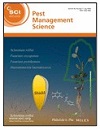Latest Publications
Coevolutionary analysis of Pseudomonas syringae–phage interactions to help with rational design of phage treatments
 Mojgan Rabiey, Emily R. Grace, Paulina Pawlos, Muscab Bihi, Haleem Ahmed, Georgina E. Hampson, Amna Al Riyami, Leena Alharbi, Rosa Sanchez-Lucas, Naina Korotania, Maria Laura Ciusa, Olivia Mosley, Michelle T. Hulin, Laura Baxter, Sabrine Dhaouadi, Diana Vinchira-Villarraga, Robert W. Jacks
Mojgan Rabiey, Emily R. Grace, Paulina Pawlos, Muscab Bihi, Haleem Ahmed, Georgina E. Hampson, Amna Al Riyami, Leena Alharbi, Rosa Sanchez-Lucas, Naina Korotania, Maria Laura Ciusa, Olivia Mosley, Michelle T. Hulin, Laura Baxter, Sabrine Dhaouadi, Diana Vinchira-Villarraga, Robert W. Jacks
Pseudomonas syringae pathovar syringae (Pss) is a major pathogen of cherry (Prunus avium) causing bacterial canker of the stem, leaf and fruit, impacting productivity and leading to a loss of trees. In an attempt to find a treatment for this disease, naturally occurring bacteriophage (phage) that specifically target Pss is being investigated as a biocontrol strategy. However, before using them as a biocontrol treatment, it is important to both understand their efficacy in reducing the bacterial population and determine if the bacterial pathogens can evolve resistance to evade phage infection. To investigate this, killing curve assays of five MR phages targeting Pss showed that phage resistance rapidly emerges in vitro, even when using a cocktail of the five phages together. This study shows that understanding the genetic mechanisms of bacterial pathogen resistance to phages is important for helping to design a more effective approach to kill the bacteria while minimizing the opportunity for phage resistance to manifest.
Ancient genomes reveal insights into ritual life at Chichén Itzá
 Rodrigo Barquera, Oana Del Castillo-Chávez, Kathrin Nägele, Patxi Pérez-Ramallo, Diana Iraíz Hernández-Zaragoza, András Szolek, Adam Benjamin Rohrlach, Pablo Librado, Ainash Childebayeva, Raffaela Angelina Bianco, Bridget S. Penman, Victor Acuña-Alonzo, Mary Lucas, Julio César Lara-Riegos, María Ermila Moo-Mezeta, Julio César Torres-Romero, Patrick Roberts, Oliver Kohlbacher, Christina Warinner & Johannes Krause
Rodrigo Barquera, Oana Del Castillo-Chávez, Kathrin Nägele, Patxi Pérez-Ramallo, Diana Iraíz Hernández-Zaragoza, András Szolek, Adam Benjamin Rohrlach, Pablo Librado, Ainash Childebayeva, Raffaela Angelina Bianco, Bridget S. Penman, Victor Acuña-Alonzo, Mary Lucas, Julio César Lara-Riegos, María Ermila Moo-Mezeta, Julio César Torres-Romero, Patrick Roberts, Oliver Kohlbacher, Christina Warinner & Johannes Krause
Here we present genome-wide data obtained from 64 subadult individuals dating to around AD 500-900 that were found in a subterranean mass burial near the Sacred Cenote (sinkhole) in the ceremonial centre of Chichén Itzá. Genetic analyses showed that all analysed individuals were male and several individuals were closely related, including two pairs of monozygotic twins. Twins feature prominently in Mayan and broader Mesoamerican mythology, where they embody qualities of duality among deities and heroes, but until now they had not been identified in ancient Mayan mortuary contexts. Genetic comparison to present-day people in the region shows genetic continuity with the ancient inhabitants of Chichén Itzá, except at certain genetic loci related to human immunity, including the human leukocyte antigen complex, suggesting signals of adaptation due to infectious diseases introduced to the region during the colonial period. Nature. June 2024
A climatic suitability indicator to support Leishmania infantum surveillance in Europe : a modelling study
 Carvalho, Bruno M., Maia, Carla, Courtenay, Orin, Llabrés-Brustenga, Alba, Lotto Batista, Martín, Moirano, Giovenale, van Daalen, Kim R., Semenza, Jan C. and Lowe, Rachel
Carvalho, Bruno M., Maia, Carla, Courtenay, Orin, Llabrés-Brustenga, Alba, Lotto Batista, Martín, Moirano, Giovenale, van Daalen, Kim R., Semenza, Jan C. and Lowe, Rachel
Leishmaniases are neglected diseases transmitted by sand flies. The aim of this modelling study was to develop an indicator that tracks climatic suitability for Leishmania infantum transmission in Europe at the subnational level. Historical records of sand fly vectors, human leishmaniasis, bioclimatic indicators, and environmental variables were integrated in a machine learning framework (XGBoost) to predict suitability in two past periods (2001–2010 and 2011–2020. This study demonstrates how key epidemiological data can be combined with open-source climatic and environmental information to develop an indicator that effectively tracks spatiotemporal changes in climatic suitability and disease risk. The positive association between the model predictions and human disease incidence demonstrates that this indicator could help target leishmaniasis surveillance to transmission hotspots.
Molecular motor tug-of-war regulates elongasome cell wall synthesis dynamics in Bacillus subtilis
 Stuart Middlemiss, Matthieu Blandenet, David M. Roberts, Andrew McMahon, James Grimshaw, Joshua M. Edwards, Zikai Sun, Kevin D. Whitley, Thierry Blu, Henrik Strahl & Seamus Holden
Stuart Middlemiss, Matthieu Blandenet, David M. Roberts, Andrew McMahon, James Grimshaw, Joshua M. Edwards, Zikai Sun, Kevin D. Whitley, Thierry Blu, Henrik Strahl & Seamus Holden
Most rod-shaped bacteria elongate by inserting new cell wall material into the inner surface of the cell sidewall. This is performed by class A penicillin binding proteins (PBPs) and a highly conserved protein complex, the elongasome, which moves processively around the cell circumference and inserts long glycan strands that act as barrel-hoop-like reinforcing structures, thereby giving rise to a rod-shaped cell. However, it remains unclear how elongasome synthesis dynamics and termination events are regulated to determine the length of these critical cell-reinforcing structures. To address this, we developed a method to track individual elongasome complexes around the entire circumference of Bacillus subtilis cells for minutes-long periods using single-molecule fluorescence microscopy. Our results demonstrate that molecular motor tug-of-war is a key regulator of elongasome dynamics in B. subtilis, which likely also regulates the cell shape via modulation of elongasome processivity.
Phenotypic and genotypic characterization of fifty strains of Beauveria spp. (Ascomycota, Cordycipitaceae) fungal entomopathogens from diverse geographic origins against the diamondback moth, Plutella xylostella (Lepidoptera: Plutellidae)
 Laura Reyes-Haro, Gillian Prince, Rommel Santiago Granja-Travez, David Chandler
Laura Reyes-Haro, Gillian Prince, Rommel Santiago Granja-Travez, David Chandler
The diamondback moth (DBM) (Plutella xylostella) causes large losses to global crop production. Conventional insecticides are losing effectiveness due to resistance. Consequently, there is a growing interest in sustainable control methods like entomopathogenic fungi (EPF) in Integrated Pest Management. However, the field efficacy of fungi varies due to environmental influences. In this study, a group of 50 Beauveria strains sourced from different locations were characterized by genotype and phenotype with respect to their conidial production, temperature and UV-B radiation tolerance, and virulence against DBM. Survival under environmental conditions is crucial for EPF-based commercial products against DBM. Results suggest strain tolerance to environmental stressors is more tied to specific micro-climatic factors than geographical origin. Each strain exhibited unique characteristics; for example, the most virulent strain (#29) was highly UV-sensitive. Therefore, characterizing diverse strains provides essential genotypic and phenotypic insights, which are fundamental for understanding their role as biocontrol agents while facilitating efficient biopesticide product development and uptake
Structures of wild-type and a constitutively closed mutant of connexin26 shed light on channel regulation by CO2
 Deborah H. Brotherton, Sarbjit Nijjar, Christos G. Savva, Nicholas Dale, Alexander D. Cameron
Deborah H. Brotherton, Sarbjit Nijjar, Christos G. Savva, Nicholas Dale, Alexander D. Cameron
Connexins allow intercellular communication by forming gap junction channels (GJCs) between juxtaposed cells. Connexin26 (Cx26) can be regulated directly by CO2. This is proposed to be mediated through carbamylation of K125. We show that mutating K125 to glutamate, mimicking the negative charge of carbamylation, causes Cx26 GJCs to be constitutively closed. Through cryo-EM we observe that the K125E mutation pushes a conformational equilibrium towards the channel having a constricted pore entrance, similar to effects seen on raising the partial pressure of CO2. In previous structures of connexins, the cytoplasmic loop, important in regulation and where K125 is located, is disordered. Through further cryo-EM studies we trap distinct states of Cx26 and observe density for the cytoplasmic loop. The interplay between the position of this loop, the conformations of the transmembrane helices and the position of the N-terminal helix, which controls the aperture to the pore, provides a mechanism for regulation.
